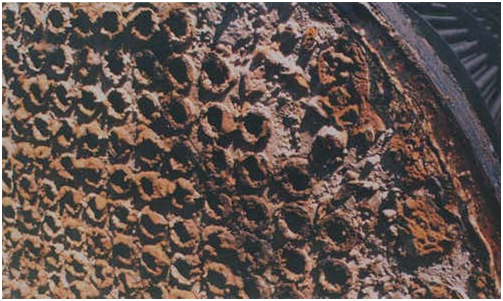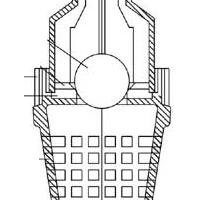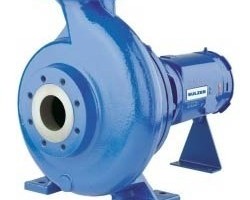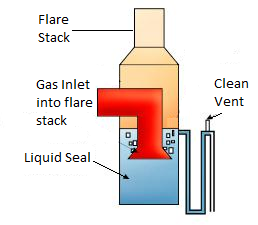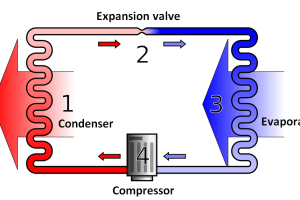Heat exchanger fouling is a common problem in different kinds of heat exchangers. Fouling is basically accumulation of dirt on the inside walls of a heat exchanger. Fouling reduces the heat transfer efficiency of an exchanger over its life. Therefore a fouling factor or dirt factor is considered in advance when designing a new heat exchanger.
During fouling, the surface of a heat exchanger wall develops another layer of solid material. This can happen for a variety of reasons.
INDEX
Heat Exchanger Fouling
Fouling factor (or dirt factor) definition
Typical fouling factor / dirt factor values
Cleaning of the heat exchanger walls
Other effects on heat exchanger design
Heat Exchanger Fouling
Fouling changes the surface of the wall between hot and cold fluids. As a result, the overall heat transfer rate through that surface is reduced.
Correspondingly, the heat transfer coefficient at the surface is drastically reduced, since the heat conducting wall metal is not in contact with the fluids any more. Instead, the wall is separated from fluids by a layer of dirty deposits. Fouling material prevents efficient heat transfer and reduces the efficiency of heat exchanger.
Heat exchanger fouling is caused by a variety of reasons such as corrosion, precipitation, accumulation of dirt or particles, accumulation of biological material etc. Depending on the kind of fouling, different kinds of solid material will accumulate on the walls of the heat exchanger.
Fouling factor (or dirt factor) definition
Heat exchanger fouling factor quantifies the effect of fouling in the reduced heat transfer efficiency. It is also often referred to as the 'dirt factor'. It normally depends on the process fluid or service on any side (shell or tube) of the heat exchanger.
Fouling or dirt factor is used for calculation of the overall heat transfer coefficient of a heat exchanger. Consider the following equation.
Where, U = Overall heat transfer coefficient
ho = Shell side heat transfer coefficient
hi = Tube side heat transfer coefficient
Rdo = shell side fouling factor
Rdi = tube side fouling factor
OD and ID are respectively the outer and internal diameters for the selected tube size
Ao and Ai are outer and inner surface area values for the tubes
kw is the resistance value for the tube wall
It is clear from the equation that, as the fouling factors (either on shell or tube side) increase, overall heat transfer coefficient will decrease. In other words, heat exchanger fouling reduces the overall heat transfer rate.
Typical fouling factor / dirt factor values
Following table represents typical values of heat exchanger dirt factor, for commonly occurring process fluids in petroleum industry.
| Fluid | Fouling Factor / Dirt Factor [(h⋅ft2⋅°F)/Btu] |
|---|---|
| Water | 0.0002 |
| Propane | 0.001 |
| Butane | 0.001 |
| Gasoline | 0.001 |
| Naphtha | 0.001 |
| Kerosene | 0.001 |
| Light gas oil | 0.002 |
| Heavy gas oil | 0.003 |
| Heavy fuel oil | 0.005 |
As expected, water has a lower dirt factor compared to hydrocarbon services. It is cleaner. Further, lighter hydrocarbons are cleaner than the heavy hydrocarbons. Therefore they have lower dirt factor values.
Cleaning of the heat exchanger walls
Dirty deposits on the heat exchanger walls can be cleaned by either mechanical or chemical methods.
- Chemical cleaning - Solid deposits which are weakly attached to the exchanger surface can be either washed with water or flushed with steam. Other dirt can be chemically cleaned using suitable solvents or weak acid solutions.
- Mechanical cleaning - When chemical cleaning is not enough, you can clean the heat exchanger surface mechanically, using techniques such as - rodding, turbining, scraping etc.
Other effects on heat exchanger design
Since fouling or dirt significantly reduces the overall heat transfer rate of an exchanger, it is important to keep it at a minimum. But, regular cleaning of the heat exchanger surface can be challenging depending on the selected TEMA configuration.
It is generally recommended to keep the dirty, fouling service on the tube side of a shell and tube exchanger for the following reasons -
- It is easier to mechanically clean the inner surface of the tubes, in a shell & tube exchanger.
- Mechanical cleaning of the inner shell surface or outer walls of the tubes is much more difficult in comparison.
- Tubes are relatively cheaper to fabricate than the shell side. Hence even if a corrosive fluid eats up the inside of those tubes in the long run, they can be replaced at a lower cost than the shell side material.
- Tubes made of expensive corrosion resistant material can be cheaper than the entire shell built out of special material.
